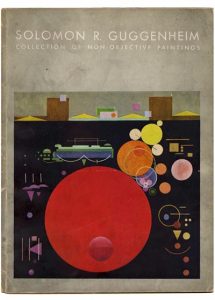 The second enlarged catalogue of the Solomon R. Guggenheim Collection of Non-objective Paintings (Internet Archive, 2017) is dedicated to the exhibition which ran from February 8, 1937 through February 28, 1937. It is presented by the Philadelphia Art Alliance. The catalogue includes text, colour and black-and-white images. It has 92 pages and is divided into: introductory words by the Philadelphia Art Alliance President Yarnall Abbott, an analytic and explanatory essay “The Beauty of Non-objectivity” by Hilla Rebay, a numbered list of artworks including the names of authors and small black-and-white pictures showing the most of enlisted artworks, a list titled “Paintings with an Object” that includes the titles of artworks and the names of authors but no images, short biographies of 19 artists, the remaining part of the catalogue – colour and black-and-white images of several artworks with their titles and names of authors, each image occupying the whole page.
The second enlarged catalogue of the Solomon R. Guggenheim Collection of Non-objective Paintings (Internet Archive, 2017) is dedicated to the exhibition which ran from February 8, 1937 through February 28, 1937. It is presented by the Philadelphia Art Alliance. The catalogue includes text, colour and black-and-white images. It has 92 pages and is divided into: introductory words by the Philadelphia Art Alliance President Yarnall Abbott, an analytic and explanatory essay “The Beauty of Non-objectivity” by Hilla Rebay, a numbered list of artworks including the names of authors and small black-and-white pictures showing the most of enlisted artworks, a list titled “Paintings with an Object” that includes the titles of artworks and the names of authors but no images, short biographies of 19 artists, the remaining part of the catalogue – colour and black-and-white images of several artworks with their titles and names of authors, each image occupying the whole page.
In the catalogue introduction we learn that the aforementioned exhibition is an outstanding event as the non-objective art collection is the most complete one in the whole world and the Art Alliance is the first one to be given the opportunity to exhibit it. Hilla Rebay has given works from her own art collection to be included in the exhibition. Besides she has been the director of the exhibition and has compiled the exhibition catalogue.
In the list of authors Hilla Rebay is one of the presented artists. She is included in both lists – non-objective paintings and paintings with an object. As regards other artists – some are represented in both lists, others only in one list. Biographies are written about all artists. The collection of large colour and black-and-white images of artworks that form the last part of the catalogue only include 4 artists while the number of artworks is 24.
The criticism to be addressed to the catalogue is that it does not seem to be an objective representation of the exhibition, as the work of some authors is emphasized much more than the work of others – the number of presented artworks for these some exclusive artists are more than 10, while other authors only have 1 work mentioned. Besides – how objective can it be if the exhibition director is the same person that compiles the catalogue, writes the main essay in the catalogue and is represented as an artist in the exhibition? It is also not clear why there is a list of artwork titles with their authors “Paintings with an Object”, if the exhibition is about non-objective painting.
The catalogue itself serves not only as a historical account of the exhibition that took place but also as an independent piece of work because such exhibition cannot be seen anymore and anyone who has a particular interest in certain works of art can only view them through this catalogue to learn and find out something new. For me personally it is interesting to see how exhibitions were organized and planned decades ago, what was considered modern and how it was communicated to the public. The catalogue provides valuable information that can be used to compare and contrast curation of different art related events in the past and nowadays. The function of the catalogue when it was produced was to inform the public of what was considered contemporary, modern and important at the time but several decades later another function has been added to it which is – to be a historical record of art, societal trends, exhibition curation. And if any of the art pieces that were in the exhibition no longer exists or is lost this catalogue is a visual memory of how that artwork looked like.
List of references
Internet Archive (2017) Second enlarged catalogue of the Solomon R. Guggenheim Collection of Non-objective Paintings: on exhibition from February 8, 1937 through February 28, 1937 Available at: https://archive.org/details/secondenlargedca1937gugg (Accessed: 12 February 2017)